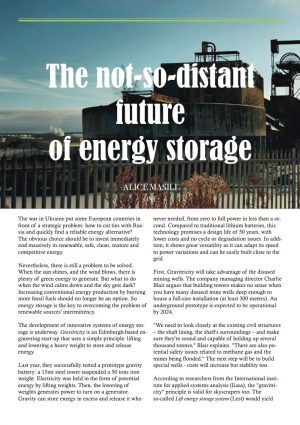 The war in Ukraine put some European countries in front of a strategic problem: how to cut ties with Russia and quickly find a reliable energy alternative? The obvious choice should be to invest immediately and massively in renewable, safe, clean, mature and competitive energy.
The war in Ukraine put some European countries in front of a strategic problem: how to cut ties with Russia and quickly find a reliable energy alternative? The obvious choice should be to invest immediately and massively in renewable, safe, clean, mature and competitive energy.
Nevertheless, there is still a problem to be solved. When the sun shines, and the wind blows, there is plenty of green energy to generate. But what to do when the wind calms down and the sky gets dark? Increasing conventional energy production by burning more fossil fuels should no longer be an option. So energy storage is the key to overcoming the problem of renewable sources’ intermittency.
The development of innovative systems of energy storage is underway. Gravitricity is an Edinburgh-based engineering start-up that uses a simple principle: lifting and lowering a heavy weight to store and release energy.
Last year, they successfully tested a prototype gravity battery: a 15mt steel tower suspended a 50 tons iron weight. Electricity was held in the form of potential energy by lifting weights. Then, the lowering of weights generates power to turn on a generator.
Gravity can store energy in excess and release it whenever needed, from zero to full power in less than a second. Compared to traditional lithium batteries, this technology promises a design life of 50 years, with lower costs and no cycle or degradation issues. In addition, it shows great versatility as it can adapt its speed to power variations and can be easily built close to the grid.
First, Gravitricity will take advantage of the disused mining wells. The company managing director Charlie Blair argues that building towers makes no sense when you have many disused mine wells deep enough to house a full-size installation (at least 300 meters). An underground prototype is expected to be operational by 2024.
“We need to look closely at the existing civil structures – the shaft lining, the shaft’s surroundings – and make sure they’re sound and capable of holding up several thousand tonnes,” Blair explains. “There are also potential safety issues related to methane gas and the mines being flooded.” The next step will be to build special wells – costs will increase but stability too.
According to researchers from the International institute for applied systems analysis (Iiasa), the “gravitricity” principle is valid for skyscrapers too. The so-called Lift energy storage system (Lest) would yield existing elevator systems in tall buildings. Some of these elevators are equipped with regenerative braking systems that can harvest energy during the elevator’s descent, so they can already be considered pre-installed energy generators.
The Lest would also use the free spaces of the building – less expensive than the construction of a dedicated gravity battery system.
The technology of the Italian start-up Energy Dome relies on a different concept. Their CO2 battery exploits a thermodynamic process that efficiently stores energy by transforming CO2 under other conditions.
The CO2 battery works in charge mode, absorbing power from the grid, and in discharge mode, releasing energy back to the grid. In charge mode, CO2 is taken from an atmospheric gasometer, the “dome”, and compressed in a compressor. The heat generated in this way is stored in two thermal energy storage systems (Tes). Then, CO2 is condensed and stored under pressure at room temperature in appropriate containers.
In discharging mode, the liquefied CO2 is evaporated and heated by recovering heat from the Tes.
CO2 flow expanded in a heated turbine returning energy to the grid and stored as a gas in the dome at ambient temperature and pressure without any dispersion into the atmosphere.
The system is capable of long-term and large-scale storage of energy. According to Claudio Spadacini, Ceo of Energy Dome, once successfully tested, the technology can be easily replicated anywhere; all you need is steel, CO₂ and water. Energy Dome estimates that it can beat lithium-ion batteries by offering up to 6 times longer life at half the price.
A first demonstration plant was recently built in Ottana, Sardinia (Italy). The Mediterranean island is blessed with wind and sun in large quantities, ideal condition to exploit renewable sources fully.
Long-life energy storage technologies are essential to support the integration of renewable energy generation. Energy storage is also a potential replacement or complement to almost every aspect of an electrical system, including generation, transmission and demand flexibility.
Once these technologies become common standards, it will signal the final passing of the baton between fossil and renewable energy.
Alice Masili





